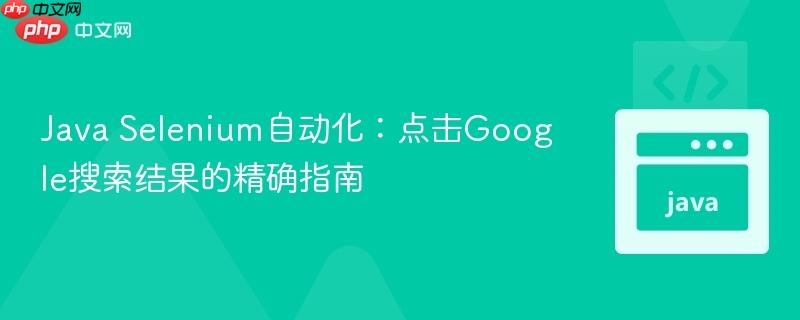
本教程详细介绍了如何使用java selenium自动化在google上进行搜索,并精确点击搜索结果中的特定链接。文章涵盖了webdriver的初始化、处理google的cookie同意弹窗、执行搜索查询、识别并点击搜索结果中的链接等关键步骤,并提供了完整的示例代码和注意事项,旨在帮助开发者高效实现google搜索结果页面的自动化交互。
引言
在使用Selenium进行Web自动化测试或数据抓取时,经常需要与搜索引擎进行交互。其中一个常见但有时具有挑战性的任务是,在Google搜索结果页面上,准确地识别并点击用户期望的链接。由于网页元素的动态性,特别是Google这类频繁更新界面的网站,直接使用简单的XPath或CSS选择器可能会遇到困难。本文将提供一个详细的Java Selenium教程,演示如何克服这些挑战,成功实现Google搜索结果的自动化点击。
环境准备
在开始之前,请确保您的开发环境中已配置好以下组件:
- Java Development Kit (JDK): 推荐使用Java 8或更高版本。
- Maven 或 Gradle: 用于项目依赖管理。
- Selenium WebDriver: 将Selenium库添加到您的项目依赖中。
- ChromeDriver: 与您的Chrome浏览器版本匹配的ChromeDriver可执行文件,并确保其路径已正确配置或通过System.setProperty()设置。
如果您使用Maven,可以在pom.xml中添加以下Selenium依赖:
org.seleniumhq.selenium selenium-java 4.x.x
自动化Google搜索与结果点击
以下步骤将详细说明如何使用Java Selenium实现自动化搜索和结果点击:
立即学习“Java免费学习笔记(深入)”;
1. 初始化WebDriver
首先,需要启动ChromeDriver实例。通常,这会封装在一个辅助类中,以便更好地管理驱动程序的生命周期。
import org.openqa.selenium.WebDriver;
import org.openqa.selenium.chrome.ChromeDriver;
// ... 其他必要的导入
public class WebDriverSetup {
public static WebDriver startChromeDriver() {
// 确保ChromeDriver路径已设置
// System.setProperty("webdriver.chrome.driver", "path/to/chromedriver");
WebDriver driver = new ChromeDriver();
driver.manage().window().maximize(); // 最大化窗口以确保元素可见
return driver;
}
}2. 导航至Google并处理Cookie同意
Google通常会在首次访问时显示Cookie同意弹窗。为了顺利进行后续操作,需要定位并点击“接受”按钮。
import org.openqa.selenium.By;
import org.openqa.selenium.WebElement;
// ...
public class GoogleSearchAutomation {
public static void main(String[] args) {
WebDriver driver = WebDriverSetup.startChromeDriver(); // 假设您有这样一个方法来启动驱动
driver.get("https://www.google.com"); // 访问Google主页
// 尝试定位并点击Cookie同意按钮
// 注意:该元素的ID可能随时间变化,需要根据实际页面进行调整
try {
WebElement acceptBtn = driver.findElement(By.id("L2AGLb")); // Google同意按钮的常见ID
acceptBtn.click();
System.out.println("成功点击Cookie同意按钮。");
} catch (Exception e) {
System.out.println("未找到Cookie同意按钮或已处理。");
// 如果没有找到按钮,可能是因为已经同意过或页面结构不同
}
}
}3. 执行搜索查询
定位搜索输入框,输入查询字符串,然后点击搜索按钮。值得注意的是,Google页面上可能存在多个同名的搜索按钮(例如,一个可见的,一个隐藏的),因此需要采取策略来选择正确的按钮。
import org.openqa.selenium.Point;
import java.util.List;
import java.util.ArrayList;
// ...
// 承接上文的main方法
// ...
String mySearchString = "fantomas wiki";
WebElement searchInput = driver.findElement(By.name("q")); // 搜索输入框的name属性通常是'q'
searchInput.sendKeys(mySearchString); // 输入搜索内容
// 定位所有名为'btnK'的搜索按钮
List searchBtns = driver.findElements(By.name("btnK"));
for (WebElement searchBtn : searchBtns) {
// 通过检查元素的位置来判断其是否可见且可点击
Point p = searchBtn.getLocation();
if (p.getX() > 0 && p.getY() > 0) { // 检查X和Y坐标是否大于0,表示在可见区域内
searchBtn.click();
System.out.println("成功点击搜索按钮。");
break; // 找到并点击后退出循环
}
}
// ... 4. 提取并点击搜索结果链接
搜索结果通常显示在一个特定的div容器中,每个结果内部包含一个或多个标签。我们需要先定位这些结果容器,然后从中提取出实际的链接。
// 承接上文的main方法
// ...
List resultLinks = new ArrayList<>();
// Google搜索结果的每个条目通常包含在class为'yuRUbf'的div中
List searchResultDivs = driver.findElements(By.className("yuRUbf"));
for (WebElement searchResultDiv : searchResultDivs) {
// 获取每个结果div中的第一个a标签,这通常就是标题链接
resultLinks.add(searchResultDiv.findElement(By.tagName("a")));
}
// 检查是否有结果,并点击第一个结果链接
if (!resultLinks.isEmpty()) {
resultLinks.get(0).click(); // 点击第一个搜索结果
System.out.println("成功点击第一个搜索结果。");
} else {
System.out.println("未找到搜索结果链接。");
}
// 页面跳转后,打印当前URL和标题进行验证
System.out.println("当前URL: " + driver.getCurrentUrl());
System.out.println("当前标题: " + driver.getTitle());
// 完成操作后关闭浏览器
driver.quit();
// ... 完整示例代码
package tests;
import java.util.ArrayList;
import java.util.List;
import org.openqa.selenium.By;
import org.openqa.selenium.Point;
import org.openqa.selenium.WebDriver;
import org.openqa.selenium.WebElement;
import org.openqa.selenium.chrome.ChromeDriver;
import org.openqa.selenium.chrome.ChromeOptions; // 导入ChromeOptions
public class GoogleSearchTest {
// 辅助方法来启动ChromeDriver
public static WebDriver startChromeDriver() {
// 请根据您的实际情况设置ChromeDriver的路径
// System.setProperty("webdriver.chrome.driver", "path/to/chromedriver");
// 可选:配置ChromeOptions,例如设置为无头模式
// ChromeOptions options = new ChromeOptions();
// options.addArguments("--headless"); // 启用无头模式
// WebDriver driver = new ChromeDriver(options);
WebDriver driver = new ChromeDriver(); // 默认启动模式
driver.manage().window().maximize(); // 最大化窗口
return driver;
}
public static void main(String[] args) {
List resultLinks = new ArrayList();
String mySearchString = "fantomas wiki";
WebDriver driver = startChromeDriver(); // 启动ChromeDriver实例
driver.get("https://www.google.com"); // 访问Google主页
// 处理Cookie同意弹窗
try {
// 注意:Google的元素ID可能动态变化,此ID为常见示例
WebElement acceptBtn = driver.findElement(By.id("L2AGLb"));
acceptBtn.click();
System.out.println("成功点击Cookie同意按钮。");
} catch (Exception e) {
System.out.println("未找到Cookie同意按钮或已处理,继续执行。");
}
// 定位搜索输入框并输入查询
WebElement searchInput = driver.findElement(By.name("q"));
searchInput.sendKeys(mySearchString);
// 定位并点击搜索按钮
// Google可能有两个同名的搜索按钮,通过位置判断可见的那个
List searchBtns = driver.findElements(By.name("btnK"));
for (WebElement searchBtn: searchBtns) {
Point p = searchBtn.getLocation();
if (p.getX() > 0 && p.getY() > 0) { // 检查元素是否在可见区域内
searchBtn.click();
System.out.println("成功点击搜索按钮。");
break;
}
}
// 提取搜索结果链接
// 每个搜索结果通常在一个class为"yuRUbf"的div中
List searchResultDivs = driver.findElements(By.className("yuRUbf"));
for (WebElement searchResultDiv: searchResultDivs) {
// 获取div中的第一个a标签,即结果链接
resultLinks.add(searchResultDiv.findElement(By.tagName("a")));
}
// 点击第一个搜索结果链接
if (!resultLinks.isEmpty()) {
resultLinks.get(0).click();
System.out.println("成功点击第一个搜索结果。");
} else {
System.out.println("未找到任何搜索结果链接。");
}
// 验证页面跳转后的URL和标题
System.out.println("当前URL: " + driver.getCurrentUrl());
System.out.println("当前标题: " + driver.getTitle());
// 关闭浏览器
driver.quit();
}
} 运行结果示例
Starting ChromeDriver 107.0.5304.62 (...) on port 20110 Only local connections are allowed. Please see https://chromedriver.chromium.org/security-considerations for suggestions on keeping ChromeDriver safe. ChromeDriver was started successfully. 成功点击Cookie同意按钮。 成功点击搜索按钮。 成功点击第一个搜索结果。 当前URL: https://cs.wikipedia.org/wiki/Fantomas 当前标题: Fantomas – Wikipedie
注意事项与最佳实践
元素定位器的稳定性: Google等大型网站的HTML结构可能经常变化。By.id()、By.name()、By.className()等定位器可能不如By.cssSelector()或By.xpath()灵活。在实际应用中,建议使用更具鲁棒性的定位策略,并定期检查定位器是否仍然有效。
-
等待策略: 网页加载是异步的,元素可能不会立即出现。在查找和交互元素之前,应使用显式等待(WebDriverWait)来等待元素可见、可点击或存在。这可以有效避免NoSuchElementException。
import org.openqa.selenium.support.ui.WebDriverWait; import org.openqa.selenium.support.ui.ExpectedConditions; import java.time.Duration; // ... WebDriverWait wait = new WebDriverWait(driver, Duration.ofSeconds(10)); WebElement element = wait.until(ExpectedConditions.visibilityOfElementLocated(By.id("someId"))); element.click(); 异常处理: 在处理可能不存在的元素(如Cookie同意按钮)时,使用try-catch块是一种良好的实践,可以使程序更加健壮。
无头模式: 对于不需要图形界面的自动化任务,可以使用无头浏览器(例如,Chrome的无头模式)来提高执行速度和效率。在ChromeOptions中添加--headless参数即可启用。
资源清理: 始终确保在自动化任务完成后调用driver.quit()来关闭浏览器并释放系统资源。
总结
通过本文的详细教程,您应该已经掌握了使用Java Selenium在Google上执行搜索并精确点击搜索结果链接的方法。从WebDriver的初始化到处理动态元素和实施最佳实践,这些技能对于任何Web自动化项目都至关重要。请记住,Web界面的动态性要求开发者持续关注和调整其自动化脚本,以确保其长期有效性。






























